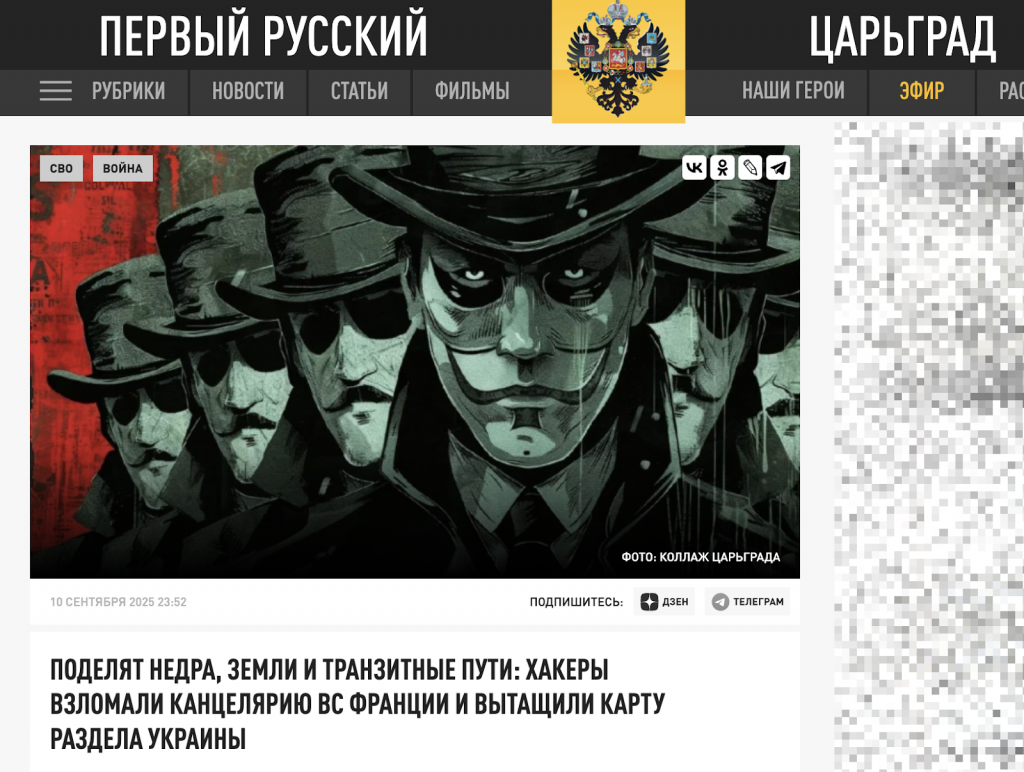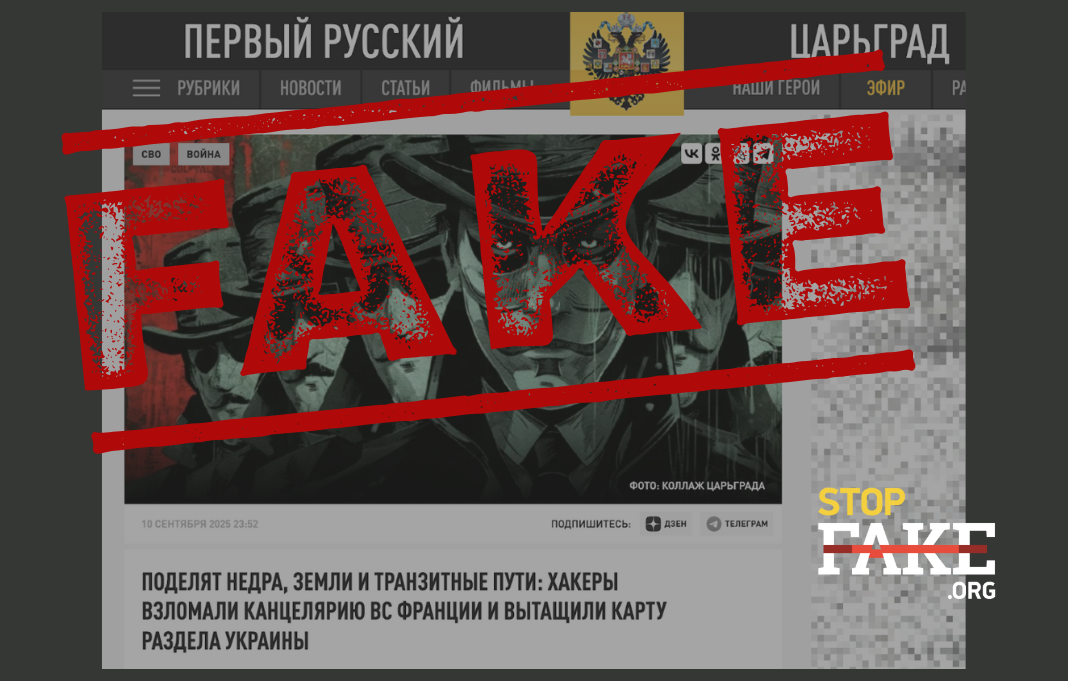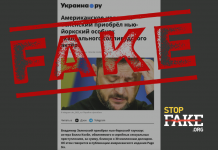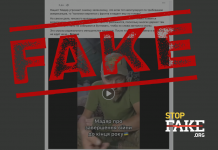The narrative of Ukraine’s supposed «division» has no basis. Statements from the «Coalition of the Willing» focus on security guarantees and continued support for Kyiv, not the partition of its territory. The map circulated by propagandists shows clear signs of fabrication — cities are labeled with transliteration errors, Crimea is depicted as «Russian», and Polish troop deployments into western Ukraine contradict Warsaw’s stated position. The inconsistencies point to a forgery designed for propaganda effect.
Russian news outlets and anonymous Telegram channels are pushing claims that the so-called «Coalition of the Willing» is preparing to send troops into Ukraine to «carve up the country for its resources». According to these reports, the allegation stems from a supposed hack by the Russian group KillNet of a French Armed Forces network. Propagandists circulated a map dated April 16, 2025, depicting foreign troop deployments on Ukrainian territory. The document is labeled Les forces conjointes de Coalition de Volontaires («Joint Forces of the Coalition of the Willing») and names General Thierry Burkhard, the former Chief of Staff of the French Armed Forces, as responsible for the project.
Propaganda outlets are now alleging that Western powers are plotting a full partition of Ukraine. Under this narrative, France would gain access to mineral deposits — including oil, gas, coal, gold, uranium, titanium, lithium, and nickel — in Zhytomyr, Kharkiv, and Sumy regions. The United Kingdom, they claim, would take control of major transport hubs and transit corridors, while Poland and Romania are supposedly eyeing territories along their borders.
Propagandists further claim that members of the so-called «Coalition of the Willing» are prepared to cede the entire territories of Luhansk and Donetsk, along with parts of Kherson and Zaporizhzhia, while recognizing Crimea as Russian. In exchange, Moscow would allegedly permit the deployment of a peacekeeping contingent in Ukraine.


The circulation of such a map, coupled with allegations that the «Coalition of the Willing» plans to send troops into Ukraine to seize control of its resources, carries all the hallmarks of a Kremlin-driven information campaign targeting Kyiv’s allies.
To begin with, the «Coalition of the Willing» has never signaled any readiness to recognize Russia’s occupation of Ukrainian territory—even in part—in exchange for peace. On the contrary, coalition leaders have consistently underscored that Ukraine’s borders cannot be altered by force and that any settlement must rest on respect for Kyiv’s sovereignty and territorial integrity. They have also made clear that a ceasefire is a prerequisite for talks, while rejecting limits on Ukraine’s military or any Kremlin veto over its European and Euro-Atlantic trajectory. French President Emmanuel Macron, UK Prime Minister Keir Starmer, and German Chancellor Friedrich Merz reiterated those positions during an August 13, 2025 meeting.
On September 4, the UK- and France-led «Coalition of the Willing» met in Paris with Ukrainian President Volodymyr Zelenskyy to outline future security guarantees designed to secure a just and lasting peace. The group agreed to establish support forces to be deployed in Ukraine immediately after a ceasefire, with 26 states already pledging to contribute ground troops or naval and air assets. Coalition representatives stressed that Ukraine’s own military must remain the backbone of any security architecture. Assertions that Western allies intend to send troops to seize resources or gain access to the Black Sea are entirely unfounded.
French President Emmanuel Macron underscored that any «support forces» would be deployed only after a ceasefire and stationed away from the front lines, in as-yet-undetermined areas, with the sole purpose of deterring future Russian aggression. He stressed that current understandings are preliminary political commitments, not finalized military blueprints. No detailed plans on zones of responsibility exist, making the purported map all the more suspect and indicative of fabrication.
Notably, the first outlet to circulate the map was the Kremlin-linked Mash, which attributed it to the hacker group KillNet. While KillNet has claimed responsibility for breaches of Ukrainian and Western institutions, its purported successes rarely withstand scrutiny. For instance, in August 2025, the group released so-called «Ukrainian Armed Forces documents» alleging over 1.7 million Ukrainian soldiers had been killed or gone missing—a figure that was clearly implausible and directly contradicted official General Staff reports.
Cybersecurity analysts say KillNet has long ceased to wield meaningful influence, with the Kremlin likely using the brand to lend credibility to its information operations. Research from Hold Security indicates that in early 2022, the group transitioned from a criminal hacker network offering DDoS services to a politically motivated collective backing Russia’s war in Ukraine. By December 2023, KillNet’s main Telegram channel had been sold to another group, Deanon Club, and its core team had largely disbanded. The founder, known as KillMilk, publicly quit, and some members departed entirely. Remaining participants merged with Deanon Club and shifted focus to targeting darknet drug marketplaces. Additionally, in 2022, KillNet received backing from the illicit Solaris platform, connected to drug trafficking and financed via cryptocurrency.
The trajectory of KillNet confirms that its operational capacity has sharply declined, even as the brand continues to be leveraged for propaganda. Analysts note that the Kremlin exploits the KillNet name as a convenient «legend» to lend credibility to forged documents, maps, and other disinformation designed to advance Russian narratives.
The map’s inconsistencies further underscore its fabricated nature. City names appear in a mix of Russian transliteration (Kharkov, Nikolaev, Krivoi Rog) and Ukrainian (Bila Tserkva), while others fail to follow standard French toponymic conventions—for example, Zaporijjia is rendered as Zaporozhye, and Khmelnytskyï as Khemelnitski. Crimea is depicted as Russian territory, despite France never recognizing its annexation and consistently showing it as Ukrainian on official maps.
In official French communication, city names are transliterated from Ukrainian. For example:

The map also raises questions by suggesting that Poland would deploy troops to multiple western Ukrainian regions—a claim that directly contradicts Warsaw’s official position. Polish authorities have repeatedly stressed that sending their army into Ukraine for a peacekeeping mission is not under consideration. While Poland participates in the so-called «Coalition of the Willing», its involvement is limited to bolstering NATO’s eastern flank and safeguarding its own security.
At the end of August 2025, Polish Defense Minister Władysław Kosiniak-Kamysz underscored that the Polish military’s priorities remain securing the Belarusian border, enhancing defense infrastructure, and providing logistical support to allies. While Warsaw may contribute to Ukraine’s security through these measures, this support does not include deploying troops on Ukrainian soil.
The narrative of a «division of Ukraine» is a longstanding Kremlin propaganda tool. Since spring 2022, Russian outlets have consistently promoted claims that Ukraine’s allies aim to «occupy» or seize its territory and resources. These disinformation efforts serve multiple objectives: discrediting Western support, sowing distrust toward international partners, undermining unity within Ukrainian society, and stoking fear of a «new partition» of the country. The Kremlin frequently employs maps, forged documents, and alleged «hacker leaks» to give these false claims an air of credibility.
StopFake has previously examined similar narratives in reports including Photo Fake: Polish Military Order to Attack Ukraine, Fake: Zelensky to Legalize «Polish Seizure of Ukraine» and Manipulation: Romania Building a Highway to the Border to Seize Chernivtsi and Zakarpattia Regions.





